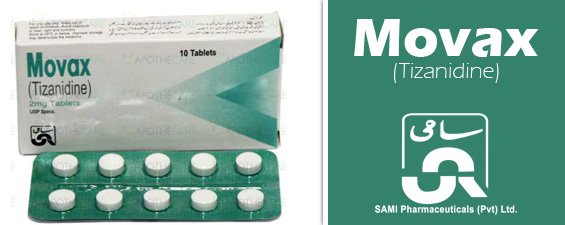- Movax 2mg Tablets contain
Tizanidine 2mg - Movax 4mg Tablets contain
Tizanidine 4mg
Movax is a centrally acting alpha-2 agonist which is a skeletal muscle relaxant. The effects of Movax are greatest on polysynaptic pathways. The overall effect of these actions is thought to reduce facilitation of spinal motor neurons.
Pharmacological Properties of Movax
- Absorption and bioavailability
Movax (Tizanidine) is rapidly and almost completely absorbed, reaching peak plasma concentration in approx. 1hour. Although Movax is well absorbed, the absolute oral bioavailability of it is about 30-40% due to extensive first pass metabolism. - Distribution
Movax is only about 30% bound to plasma proteins. - Metabolism
Movax Tablet undergoes rapid and extensive metabolism in the liver. Its metabolites are not known to be active. - Elimination
Excretion primarily is via renal route (approx. 70% of the administered dose). The elimination half-life of movax Tablet from plasma is 2-4hours. Concomitant food intake has no influence on the pharmacokinetic profile of Movax tablets.
What is Movax Used For?
Movax is primarily used for the treatment of painful muscle spasms associated with static and functional disorders of the spine (cervical and lumbar syndromes), following surgery e.g. for herniated intervertebral disc or osteoarthritis of the hip and muscular spasms associated with accidental trauma.
Movax is also in cases like spasticity due to neurological disorders e.g. Multiple sclerosis, chronic myelopathy, degenerative spinal cord diseases, cerebrovascular accidents and cerebral palsy.
Recommended Dosage of Movax Tablets
The effect of Movax (Tizanidine) on spasticity is maximum within 2-3 hours of dosing and it has a relatively short duration of action. The timing and frequency of dosing should therefore be tailored to the individual and Movax should be given in divided doses, up to 3-4 times daily, depending on the patient’s needs. There is considerable variation in response between patients so careful titration is necessary. Care should be taken not to exceed the dose producing the desired therapeutic effect. It is usual to start with a single dose of 2mg increasing by 2mg increments at not less than half-weekly intervals. The total daily dose should not exceed 36mg, although it is usually not necessary to exceed 24mg daily.
Elderly:
Experience in the elderly is limited and use of Movax Tablets is not recommended unless the benefit of treatment clearly outweighs the risk. Pharmacokinetic data suggests that renal clearance in the elderly may be decreased by up to three folds.
Children:
Experience with Movax in patients under the age of 18 years is limited therefore it is not recommended for use in children.
Movax in Patients with Renal impairment
In patients with renal insufficiency (creatinine clearance <25mL/min) treatment should be started with 2mg once daily with slow titration to achieve the effective dose. Dosage increases should be in increments of no more than 2mg according to tolerability and effectiveness. It is advisable to slowly increase the once-daily dose before increasing the frequency of administration. Renal function should be monitored as appropriate in these patients.

Very effective medicine.